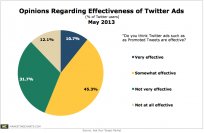Q: Where can I get reliable response rate statistics for different advertising media?
A: I'm wagering you'd like to calculate your own, personal answer to the age-old question: "If I spend this much money on advertising, what can I expect to see as a result?"
A few years ago, a team from the Wharton School of Business at the University of Pennsylvania in Philadelphia set out to establish the definitive answer to that very question. Pepsi, Frito-Lay, Colgate-Palmolive and a host of other big companies collectively invested more than a million dollars so that Wharton might track the return-on-investment experienced by several dozen small businesses as a result of advertising. These businesses were scientifically monitored and measured for seven long years. The final report filled more than 2, 500 pages. Only three conclusions were reached:
1. There is no direct correlation between dollars invested and results gained. In other words, how much you spend and what you can expect to see in return are not directly linked by any kind of mathematical equation.
2. Results are inextricably linked to the message. Two advertisers invest the same amount of money reaching the same target audience. One succeeds brilliantly and buys the mansion on the hilltop. The other fails miserably, receiving no response whatsoever. The difference between these two was in the message of their ads.
Ads that speak to the heart of the customer and touch a nerve are the ones that turn little companies into big companies. But few people know how to write such an ad. Most business owners approach advertising with the goal of merely getting their name out. But there is no evidence to suggest this will help you in the slightest. The Wharton study indicates that everything hinges on the message you attach to your name. Is your message predictable and, consequently, boring? Is it believable? Is it relevant to the perceived need of the reader/listener/viewer? Tempt a dog with a bowl of rice, and he'll ignore you. Put a steak in the bowl, and you'll have his undivided attention. Your prospective customers are no different. What have you been putting in their bowls?
3. Results increase with repetition. When you've identified a message that generates a positive response and you deliver that message consistently, business growth in year two will be approximately twice the growth of year one. Growth in year three will be approximately triple the growth of year one, with growth measured in dollars, not percentages. But following year three, anything can happen. Your business can explode exponentially, or it can flatten out as though hitting an invisible glass ceiling. I've seen clients grow to 70 times their original size, and I've seen clients slowly grow to only double or triple their original volume and then flatten out. The difference is in the clients, not in the ads.
The follow-up question I'm sure you're dying to ask is, "OK, let's assume we've found a message that works. Now which medium is going to give me the most for my money?" Again there's no simple answer, but I'll try to give you a frame of reference. These are the major media, with some more expensive than others. The one that's right for you depends entirely on your business.
- Outdoor advertising/billboards: These reach more people for a dollar than any other media, but are limited to a picture and no more than eight words.
- Radio: Reaches the second most people for a dollar, but cannot be targeted geographically and can only be loosely demographically targeted. But if people will drive significant distances to buy your product, or if you're selling a "we come to you" service, this is likely your best bet.
- Cable television: Offers the impact of moving images as well as spoken words. Can easily be geographically targeted. But your ad will likely look homemade.
- Broadcast television: Big prestige. Big bucks. But able to target psychographic profiles. Buy specific shows; never buy a rotator.
- Newspapers: Reach customers who are in the market to buy today. Unfortunately, people not currently in the market for your product or service are less likely to notice your ad than if it had appeared in another media.
- Magazines: Expensive, but high-impact with tight targeting. Little waste. Weakness is infrequency of repetition.
- Direct mail: Highly targeted, all the way down to the level of the individual. But shockingly expensive to do right.
- Yellow Pages: Essentially a service directory for the customer who has not yet made up his or her mind. Very foolish for retail businesses.











